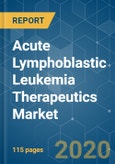One of the major factors responsible for the growth of this market includes the rising occurrence of acute lymphoblastic leukemia (ALL) globally. The number of new cases being recorded each year is around 1.7 per 100,000 men and women per year. It has been estimated by the American Cancer Institute that in 2019, there will be around 5,930 new cases of ALL i.e. 3,280 in males and 2,650 in females. In addition, by 2020, it has been estimated that the number of cases of ALL may range around 0.4 to 2 per 100,000 population in the Asia-Pacific and South American countries.
There is a rise in the number of cases primarily due to the adoption of western lifestyles, including dietary changes and sedentary lifestyles. Moreover, globally, the prevalence is expected to increase during the forecast period, which shall be the major factor for the growth of this market.
Key Market Trends
Chemotherapy is Expected to Dominate the Type of Therapy Segment
The American Cancer Association stated that chemotherapy is the main treatment for the people suffering from acute lymphoblastic leukemia (ALL), and it has three phases, such as remission, consolidation, and maintenance. Chemotherapy uses cytotoxic drugs for the destruction of cancer cells.
Amsacrine (NordMedica), cyclophosphamide (Baxter), and cytarabine (Pfizer) are some of the drugs that are used for chemotherapy in ALL. Global pharmaceutical players, such as Baxter International, and Pfizer, are providing these drugs. ALL is the most common cancer in children, adolescents, and young adults younger than 20 years, accounting for 19.8% of all cancer cases in this age group, as per a 2019 report by the Leukemia & Lymphoma Society. Hence, the market for chemotherapy is also expected to boost due to high prevalence of ALL, especially among children.
North America to Dominate the Market Over the Forecast Period
North America is expected to dominate this market, due to the rising number of cases of this disease in the region, owing to genetic factors, environmental factors, and radiation. Moreover, favorable government policies, well-established healthcare infrastructure, and the presence of multinational companies make this region dominant in this market.
Asia-Pacific is also expected to register a high CAGR during the forecast period, owing to several factors, such as high unmet clinical needs, huge patient pool, and the rising awareness about early diagnosis in emerging countries.
Competitive Landscape
The market for acute lymphoblastic leukemia is moderately competitive and consists of the big players as well as the mid-sized companies. Owing to the rising focus of most of the pharmaceutical companies on oncology, it is expected that few new small-sized companies will also penetrate the market in the near future.
Reasons to Purchase this report:
There is a rise in the number of cases primarily due to the adoption of western lifestyles, including dietary changes and sedentary lifestyles. Moreover, globally, the prevalence is expected to increase during the forecast period, which shall be the major factor for the growth of this market.
Key Market Trends
Chemotherapy is Expected to Dominate the Type of Therapy Segment
The American Cancer Association stated that chemotherapy is the main treatment for the people suffering from acute lymphoblastic leukemia (ALL), and it has three phases, such as remission, consolidation, and maintenance. Chemotherapy uses cytotoxic drugs for the destruction of cancer cells.
Amsacrine (NordMedica), cyclophosphamide (Baxter), and cytarabine (Pfizer) are some of the drugs that are used for chemotherapy in ALL. Global pharmaceutical players, such as Baxter International, and Pfizer, are providing these drugs. ALL is the most common cancer in children, adolescents, and young adults younger than 20 years, accounting for 19.8% of all cancer cases in this age group, as per a 2019 report by the Leukemia & Lymphoma Society. Hence, the market for chemotherapy is also expected to boost due to high prevalence of ALL, especially among children.
North America to Dominate the Market Over the Forecast Period
North America is expected to dominate this market, due to the rising number of cases of this disease in the region, owing to genetic factors, environmental factors, and radiation. Moreover, favorable government policies, well-established healthcare infrastructure, and the presence of multinational companies make this region dominant in this market.
Asia-Pacific is also expected to register a high CAGR during the forecast period, owing to several factors, such as high unmet clinical needs, huge patient pool, and the rising awareness about early diagnosis in emerging countries.
Competitive Landscape
The market for acute lymphoblastic leukemia is moderately competitive and consists of the big players as well as the mid-sized companies. Owing to the rising focus of most of the pharmaceutical companies on oncology, it is expected that few new small-sized companies will also penetrate the market in the near future.
Reasons to Purchase this report:
- The market estimate (ME) sheet in Excel format
- 3 months of analyst support
Table of Contents
1 INTRODUCTION
4 MARKET DYNAMICS
5 MARKET SEGMENTATION
6 COMPETITIVE LANDSCAPE
Companies Mentioned (Partial List)
A selection of companies mentioned in this report includes, but is not limited to:
- Bristol Myer Squibb Company
- Celegene Corporation
- Eisai Co Ltd
- Erytech Pharma
- F. Hoffmann-La Roche Ltd
- Genmab A/S
- GlaxoSmithKline PLC
- Novartis AG
- Pfizer Inc.
- Sanofi SA
Methodology

LOADING...








